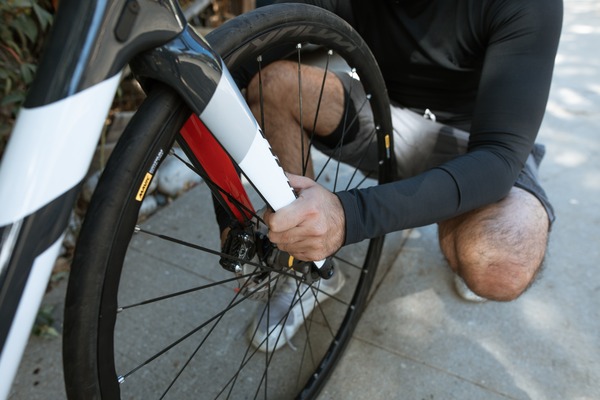If your bike has carbon forks, you may have wondered why, and what the benefits of this…
Why do bikes have carbon forks?
Carbon forks are ideal for your bike for two reasons. First, they are about 50% lighter, which means that you are going to get much better speed from the simple fact that your bike will now weigh less. They are also quite durable, having a high tensile strength due to the carbon layering, but there is a caveat.
While carbon is durable and can last longer than steel in most cases, it is not quite as impact resistant as a steel fork in the case of a high-impact accident. Even so, the durability is close enough that most cyclists feel that the longevity and the weight difference make a carbon fork the superior choice.
What is the advantage of a carbon fork on a bike?

A carbon fork is durable and very light – in fact, it weighs about half as much as a steel fork. Due to the weight difference, your bike will be considerably lighter with a carbon fork, and you will reap the benefits of this by increased speed.
They are also quite durable, lasting an estimated 10,000 cycling sessions with a base weight of 270 pounds – which is not too shabby for a lightweight alternative to steel.
Is a Carbon fiber fork worth it?
Yes, carbon fiber forks are a good investment. They will make your bike lighter and they are more durable than aluminum and almost as durable as a heavier steel fork. Having your current fork replaced with a lighter carbon fiber model will also give you the better performance to go with the extra speed.
As such, a carbon fiber fork is a worthwhile upgrade and if you take care of it, it can last a very long time indeed.
What does a carbon fork mean on a bike?
When you hear the term ‘carbon fiber fork’ then what is being mentioned is a fork that is made of carbon fiber, which is technically a polymer of graphite. Other popular forks include Aluminum, which is made of aluminum alloy, and steel bike forks, and they have their perks as well.
The biggest difference with a carbon fork will be the weight. It is lighter than aluminum and steel, but both of those alternatives are more durable, with steel being the toughest.
Does carbon fork break easily?
Not easily, no, but it can break and when it does, it’s a little different than an aluminum or steel fork. That’s because carbon is not a metal, but rather a graphite polymer. That said, it is very durable and is a material used in the aerospace industry and formula one cars, so if you are worried about it cracking easily then you can rest easy.
While it can be shattered in a high-impact crash, this is not as common as you would think, and in most cases that we have seen the most damage has occurred when a metal bike component was fused to the layered carbon. Do a Google search on ‘carbon fork breaking’ and you can see for yourself.
It’s hard to find a lot of examples because this material is very strong, despite those rumors being spread from other cyclists who are just skeptical. After all, it’s not aluminum or steel.
Do carbon forks make a difference?
Yes, they do. If you are going to be commuting to work, for instance, you’ll notice the difference in handling and you’re going to be traveling a bit faster. That’s because the carbon fork is lighter than aluminum and steel alternatives.
As far as ‘how much lighter’, try 50%! The layered carbon fiber is a polymer of graphite, and graphite is not a metal, so you’re going to notice the difference in the weight.
To give you a better idea of its reliability, take a look at the aerospace industry – they use carbon fiber all of the time for durability and lightness!
How often do carbon forks fail?
It depends on the quality of the layering in the carbon fork. A strong carbon fork will last approximately 10,000 cycles, assuming that the rider is a weight of up to 270 pounds. Lighter riders will get a longer performance lifetime, but if the carbon fork is of poor quality, that can reduce the life to 5000 cycling sessions.
That’s why it’s a good idea to research your vendor and pay a little extra for a better carbon fork. A small investment now can get you as much as twice the quality, so it’s worth your while.
Do carbon forks absorb shock?
Yes, carbon fiber is an excellent absorber of shock, even more so than the metal alternatives such as aluminum or steel. When it is layered correctly, a carbon fiber fork is highly resilient, resistant to shock, and about half the weight of its metal competition.
This makes them an ideal upgrade for cyclists who would like a little extra performance and speed without sacrificing durability.
What is a disadvantage of using carbon fiber for bikes?

The biggest disadvantage is generally the cost. You’ll notice that carbon fiber comes as an expected feature mostly in mid-range to high-range models, and this is because it is more costly to manufacture than aluminum or steel forks.
While metal is more easily shaped, carbon requires a layering technique to ensure that the graphite polymer is going to be both lightweight but also effectively shock-resistant.
As a good carbon fiber construct will last a long time and weigh half as much as the metal alternatives, it’s worth the cost if you don’t mind investing a little more now so that you can enjoy the benefits.
How long will a carbon bike frame last?
While you hear a lot of gossip about carbon, it is mostly uninformed when it comes to the durability of the material. Unless you are in a very high-impact accident or if someone ‘goes after’ your bike with a sledgehammer, it’s going to last virtually forever.
When carbon fiber is layered properly, then metals are typically going to fatigue well before the carbon will – and we’re talking about extra years here, to be clear. It’s that durable and when you add in that it’s 50% lighter than steel, a carbon bike frame is worth considering.